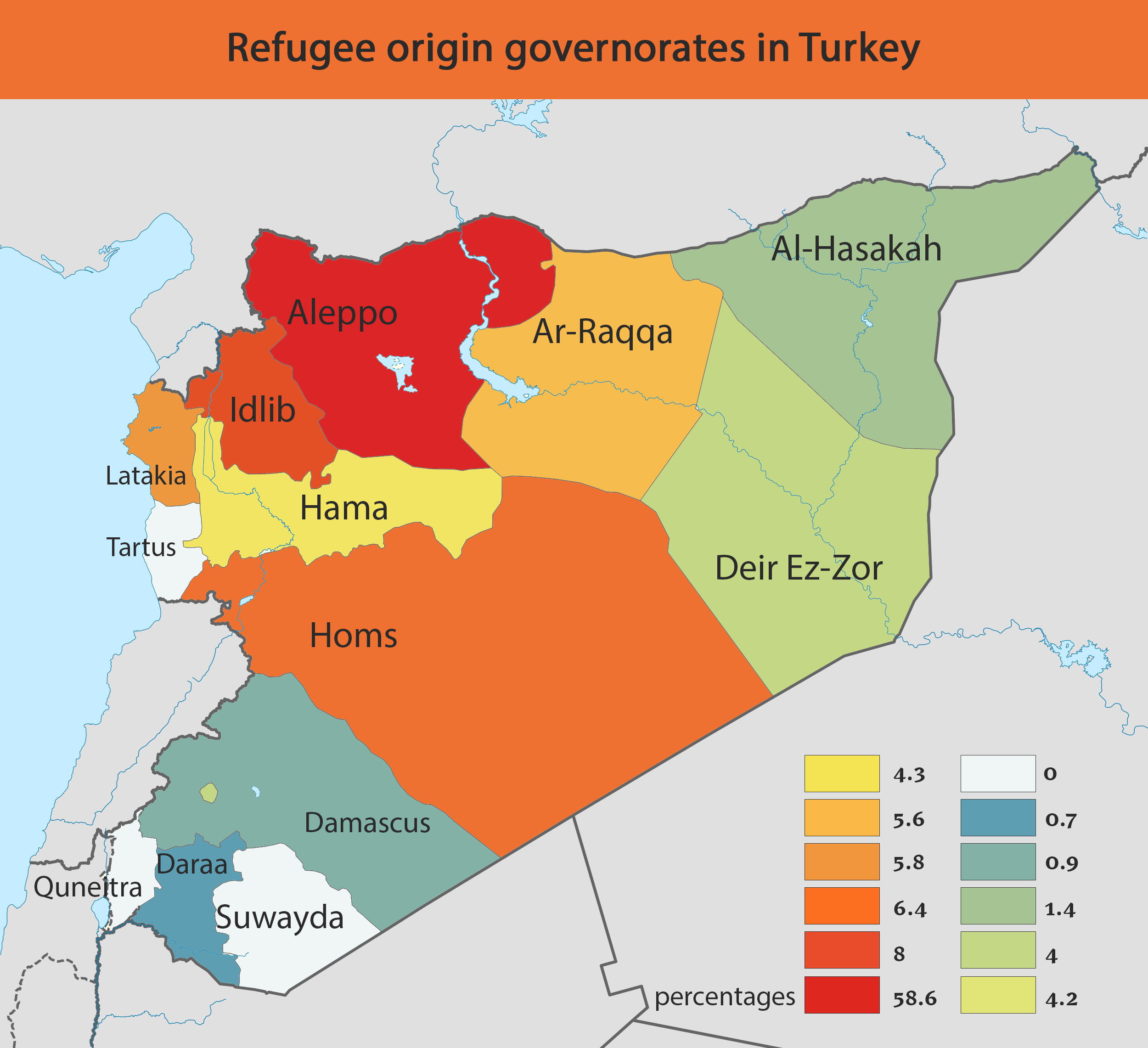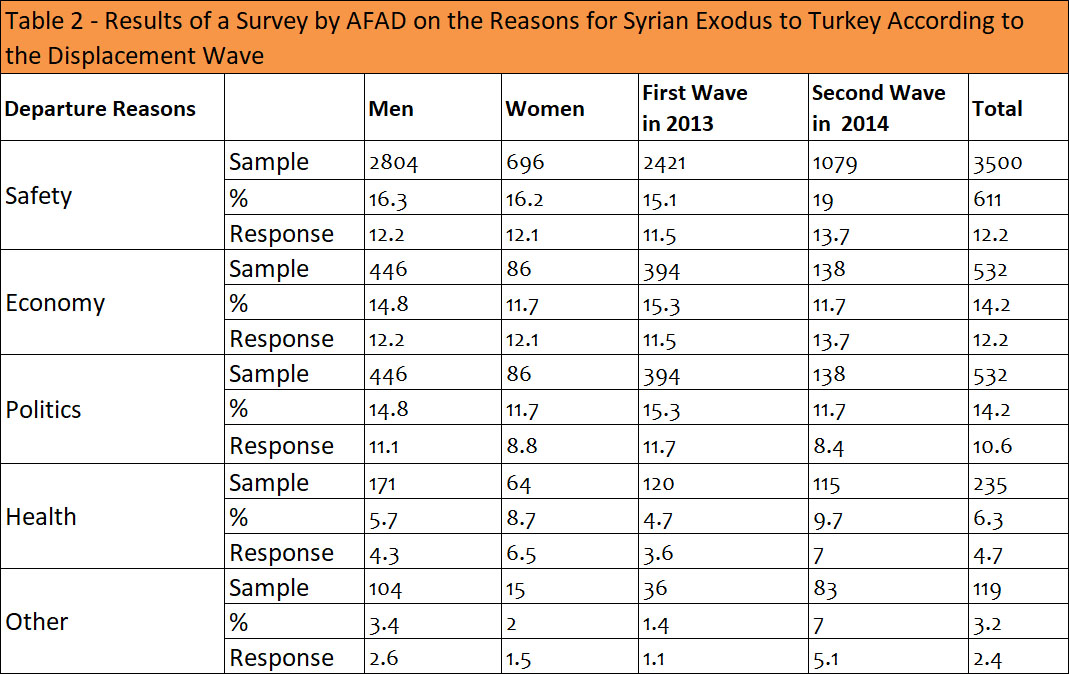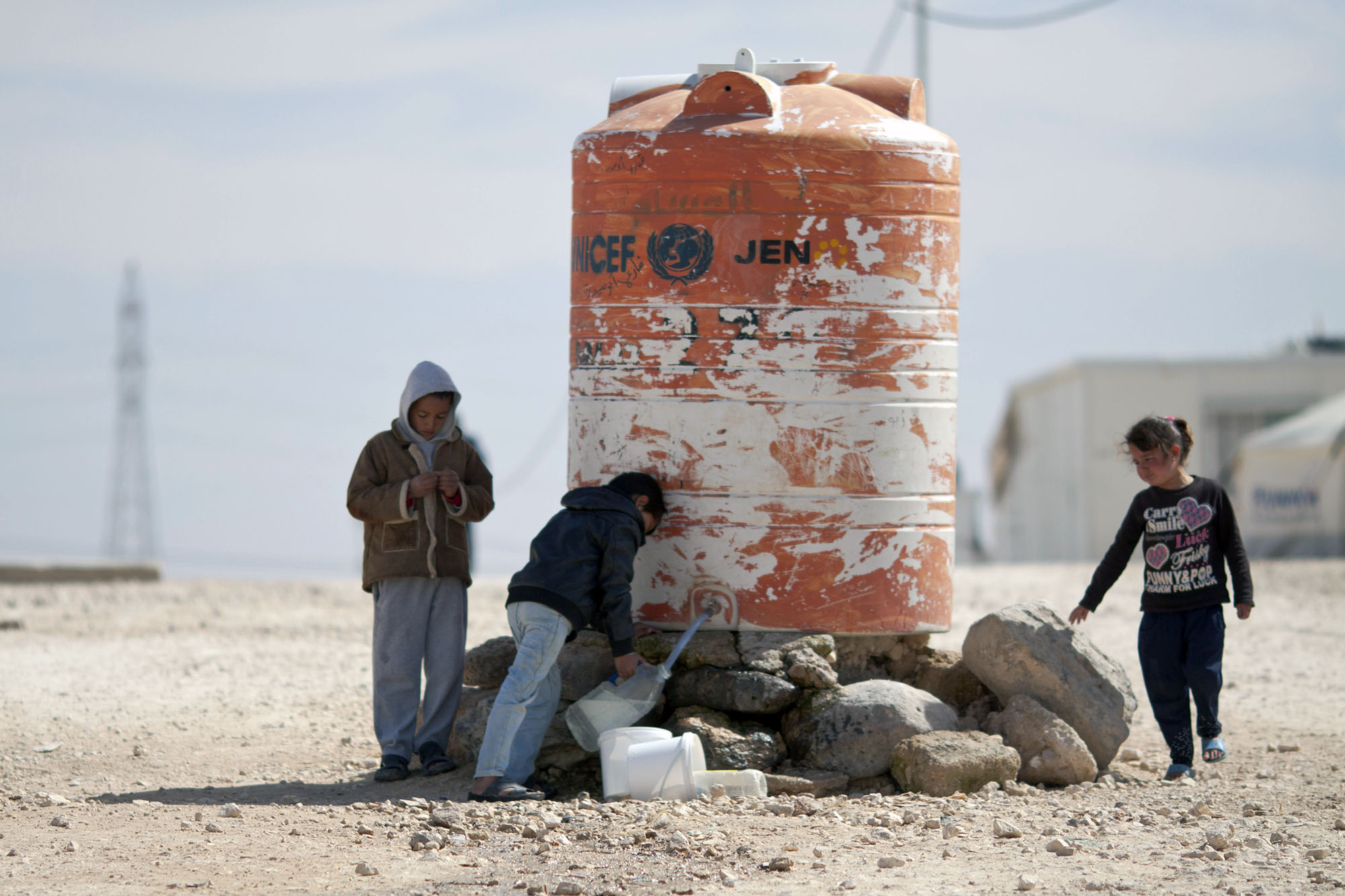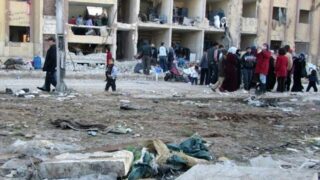March 2019 marks the eighth anniversary of the Syrian war. And up until the end of the year 2017, 6.2 million Syrians had gone through involuntary internal migration, some of whom returned to their regions, while 5 million more remain stuck in bordering countries. This is out of a total population of 18.5 million Syrians.
This paper raises questions about the reasons for and factors affecting the movements of Syrians in their involuntary migration towards one region or another. It investigates the paths they take, and the influence of domestic factors on the directions of internal and external migration. The size of these migrations and their class distribution are also taken into consideration.
Syrian conditions up to the outburst of 2011
The 2011 revolt was not only due to Syrians being barred from political participation in decisions about their affairs, but to the cumulative disappointments of the previous decades. There was nation-wide disappointment in a corrupt system that produced consecutive crises in a country endowed with enough economic and social riches to allow its citizens to live with dignity.
One manifestation of these clear social and developmental failures is ongoing internal migration since the 1980s. But the authorities dealt with migration as a mere statistical indicator, without creating a strategy to deal with its consequences. The inefficient use of various resources led to continuous draining of the population, the environment, and the skills. And as a result of climate change and waves of drought hitting the globe – beyond the behaviors of the Syrian population – the soil in the Jazira region became salinized. Rich in oil and wheat, the region was dubbed the “California” of Syria since the 1950s, but water resources were depleted due to misuse, lack of planning, and the establishment of Turkish dams along the Euphrates. These factors lead to the migration of 300,000 Syrians from the Jazira to the outskirts of Damascus, Aleppo, and the interior regions staring in the 1980s. In the meantime, corruption in project management in other regions meant the contribution of the agricultural sector – the foundation of the Syrian economy – to GDP was reduced from 36 percent to 21 percent in the 1990s. The industrial and services sectors followed, with similar percentages.
The neoliberal approach to the economy further prevailed from the beginning of the twenty-first century, leading to the elimination of basic supply subsidies and the gradual privatization of education, health, and industry amid clear administrative and governmental failure. The rate of growth dropped to a mere 4 percent. Hundreds of craft shops and small business in the cities shut down and unemployment surged to 39 percent in 2012, mostly for the largest population bracket, namely those under 40 years old (36 percent of the population). This necessitated the creation of thousands of jobs, which was not achieved. Consequently, a quarter of the population migrated to major urban areas, creating unplanned districts on the city borders. City populations exploded, with the capital alone becoming home to 5 to 6 million people – a third of the Syrian population. This is how Syria accumulated the factors that lead to several outbreaks of protest, ultimately leading to the March 2011 movement.
By resorting to violence in response to the protests, the government swiftly turned the country into a battlefield for a confrontation with the people. It also opened up the door of migration from the early days, specifically since March, to pressure neighboring countries. This was when 5,000 Syrians migrated from Damascus and Homs to Lebanon; then, in May 2011, the first Syrian refugee camp was set up in Turkey’s Antalya. Jordan became a destination in July, and by December 2012 half a million Syrians had been displaced from the country, as displacement and involuntary migration started in earnest – with still no end in sight yet. Later, the appearance of Islamic State (IS) as a player accelerated the increase in numbers of displaced people.
The eruption of internal displacement
Syrians’ displacement came in sudden, consecutive waves that followed the turning points in the crisis and the evolution of the war itself. The movements reflected “last-minute” migrations of groups of people going through their own critical shifts. The cities were first to erupt, with people pushed out of their homes in the thousands; then the villages. Individuals' displacement did not necessarily stop at one destination, but often recurred dozens of times; many beceme stuck in cut-off regions.
- The first wave
During the initial months of protest, the policy was to blockade cities to stifle and starve residents and disseminate rumors of raids. This led to waves of forcible displacement to nearby, relatively quiet regions. Jisr al-Shughur, Daraa and Homs were largely emptied in this way by the end of 2012, in the first wave of involuntary migration. These people had the luxury of choosing to go to other cities that had not yet been destroyed. The wealthiest were the first to leave the country. At the time, the UN estimated 3 million internally displaced. In 2013 alone, at least 36 cities and towns were completely or partially under blockade. Their residents were waiting for any opportunity to leave.
Forty-six-year-old physics professor Yasser J. currently resides in Antalya in Turkey. He was one of the first Syrians to leave Jisr al-Shughur – 45 kilometeres from Idlib. “We expected the city to be stormed after some of the regime’s security personnel were killed by militants at the end of 2012,” recounts Yasser. “Rumors spread of massive military forces are coming towards the city. Fear got the upper hand, and several families began finding their way towards Idlib.”
In 2012 and 2013 the opposition controlled vast areas, and the crisis took a new turn when air forces entered the conflict and explosive barrels were used in the winter of 2013. Repeated bombing of cities began, failing to distinguish between people and stone. The bombing particularly focused on the unplanned areas on the outskirts of cities, created by earlier displacements. A lot of people thus left the cities, their surroundings and conflicts, each seeking safety through the paths available to them and that they could afford. Hundreds of civilians died while escaping. The Syrian Network for Human Rights reported that nearly 5000 civilians, from the Qaboun, Barzeh, Jobar and other districts, died while fleeing battles around the capital in the south.
From another region, that of Raqqa in the north, fifty-six-year-old “Mahmoud Soliman,” who migrated to the Syrian port city of Latakia, says: “The first wave of displacement began when Raqqa fell to the ‘Free Army.’ Later, Raqqa was bombed with rockets and missiles [by the government]. Then there was another round of bombing in summer 2013 by Al-Nusra Front conjointly with the fall of Idlib. So a group of people travelled to the south through Sukhnah and Palmyra to Damascus, and the largest group exited with the entry of IS to the city and the rural areas around it. Then, as the international coalition forces [US, European and Arab countries] arrived in 2014, and the ‘Syrian Democratic Forces’ (SDF) to fight IS in 2015, there was no longer a livable place in the city. Tens of thousands of people gradually left.” Raqqa’s residents decreased gradually from 1 million in 2011 to 150,000 by the time the coalition forces entered the war, destroying more than 80 percent of the city’s infrastructure.
- The second wave
Armed conflict had killed nearly half a million by the end of 2014. When passageways out of blockaded cities opened due to international pressure, those who had remained left, marking the second major involuntary migration wave, between 2014 and 2015. These people left in haste, taking only their clothes, and sometimes without even personal documents. A picture taken at the time shows that meals were left uneaten on tables.
The armed opposition had taken over 70 percent of Aleppo by the end of 2012, in addition to having almost complete control of the surrounding rural areas. Between 2013 and 2016, air raids, barrel bombs, and battles emptied high-density districts, such as Hananu, Sakhour, Shaar and Haydariyeh, of original residents and refugees alike. Displacement also left districts such as Karam Jebel, Salaheddine, Sayf al-Dawla, Amriyah, Bustan al-Qasr and others utterly lifeless, with no residents remaining. These districts were destroyed due to their position in the war as frontlines for several years, known as East and West Aleppo crossings. Many of those displaced joined the 2 million displaced people in government-controlled coastal areas and Damascus, while others joined the 1.5 million – most of those displaced from rural areas, in nearby Turkey.
- The third wave
The Russian intervention of August 2015 prompted the third major involuntary migration. Russia’s bombing of dozens of districts led to the systematic displacement of people under the cover of reconciliation with the besieged districts that the government had entered. According to data from the Assistance Coordination Unit (in northern Syria), more than 70,000 people were moved from East Ghouta, Qalamun, and Yarmouk in rural Damascus, in the green buses of the Syrian government, in coordination with the UN and civil society groups. In this turning point for involuntary migration of Syrians, the buses passed by Qalaat al-Madiq and Al-Bab. A large number were moved to the city of Afrin, while others were housed in the Deir Ballout Camp under the management of Turkish AFAD.
The scene was repeated in rural Homs and Daraa, where more than 40,000 people including armed militants and their families were moved to areas in the north with the permission of Turkey. After they arrived, they were dispersed over dozens of locations, including Zoghra Camp, which houses people previously displaced from Homs. Externally displaced people from Deir ez-Zor, Hama and Aleppo were dispersed over 20 other settlements such as al-Mayadeen and Ain Saadeh, where residents exceed 200,000.
On the other side, attacks by the armed opposition on rural areas surrounding Latakia resulted in mass involuntary migration towards coastal cities, and conflicts among the opposition factions in areas under their control led to further migration between cities and villages in the north. Fleeing the fighting in the northern cities, some 50,000 displaced people went to Maarat al-Numaan and al-Dana and built a camp at Jisr al-Shughur.
External Displacement
It was clear from the early days of the crisis that it would last for a long time. This prompted many to consider leaving the country through the means available at the time among Syrians who were also facing declining economic and security conditions and worsening services. During that time the authorities were not stepping up to deal with this decline and civil society had reached the limits of its ability to help the displaced people.
In January 2012, around half a million people were displaced from various regions, most significantly the rural areas around Homs, Idlib and Damascus. Most of these areas are near international borders. People found various ways to get into bordering countries: some were legal, but most people resorted to existing informal means of migration. Some people walked for dozens of kilometers to flee bombing and death and air forces. Ahmed Qusayr, who currently lives in Lebanon, says: “ِAfter Al-Qusayr fell [to the government in June 2013] and arrest campaigns began, I walked to al-Nabek, and from there to Yabroud, and from there through the mountains to Lebanon in a journey that lasted around a week.”
By the beginning of 2014, half of Homs (known Syria’s Dresden) had been reduced to ashes. Most families resident there fled from battle-afflicted districts such as Baba Amr, Al-Khaldeeye, Al-Kussur and Juret al-Shayah, which were flattened. They fled to the countryside surrounding Homs, which subsequently experienced month-long battles. Hence came the collective escape through Lebanon’s Wadi Khaled to northern regions and Bekaa Valley, where the largest concentration of Syrian refugees – around 250,000 people – reside. Tens of thousands fled from Qalamun to Lebanon – their only choice. Some of the latter group still reside in mountain camps next to the municipality of Arsal, in dire living conditions. In 2019, almost a million Syrians live in Lebanon, more than half of whom remain refugees there.
Residents of the border areas with familial and other ties with the other side were not the only people to cross into neighboring countries. A large portion of the populations of Duma, Darayya and Daraa fled from the battles and the possibility of arrest early on, especially those who were antagonized and feared arrest through nine checkpoints between As-Suwayda and Damascus. Around 320,000 people fled into Jordan in 2012. Those barred from entering Jordan in 2013 ended up stuck in Jordan’s Zaatari Camp, which contains more than 150,000 people. Today there is a total of 625,000 in camps in Jordan, in addition to a few thousand living in a camp just on the Syrian side of the border, Rukban. The Syrian government, Jordan, Russia and the US are currently curtailing the amount of food and goods allowed into the Rukban Camp and imposing other restrictions due to its location near Tanf (southern Syria) where US forces are positioned.
Only a few people from As-Suwayda were displaced, says journalist Ahed Murad. And “because the young men were called up from the reserve service to active duty, the rate of migration to Erbil, Lebanon and the US increased while the involuntary migration of the residents of Daraa put them on a path to Jordan due to geographical proximity and tribal ties.”
“Some of those who arrived in Jordan, especially urban residents, had work connections, but many rural residents ended up in camps depending on aid for their livelihood because of Jordan’s tight labor market and laws that prohibit hiring Syrians. Other rural displaced people from Jordan ended up living in unplanned areas in Jordanian cities. Most young people considered Jordan, like Lebanon, a stop-off point en route to Turkey then Europe.”
In the north, Turkey received a lot of refugees from border areas. Some came fleeing battles between the government and IS from one side and conflicts among oppositional factions on the other side. By 2018, Syrian refugees in Turkey totalled 3.2 million, distributed over Atme, Antalya, Adana and Gaziantep camps, which house 10 percent of the Syrian population. Syrians also spread out across Turkey. In Egypt, there are an estimated half a million Syrians, mostly well-off families who have had a positive impact on the Egyptian economy by establishing weaving and food factories and businesses in the services sector.
Displacement pathways are compulsory
Displaced Syrians did not have a lot of choice once they left their hometowns. Moving to government-controlled areas risked arrest or, for young men, recruitment to the military, which was rejected by most of the population of the areas affected by the war. Therefore people chose opposition areas in the north and south. From there, they left the country. In many cases, especially after Iran’s intervention in the war, refugees were directed to border areas or prevented from entering certain areas. This depended on the political side taken by the population of a certain city or town. Those from areas where there were protests were displaced or chose to move to areas controlled by the opposition in the north or left the country.
In Damascus and the surrounding countryside, those displaced from Darayya, Duma, Al-Nashabiyah, Mesraba, Al-Zabadani and elsewhere were not allowed into the capital as the government perceived them as oppositional. They moved collectively to the south to Daraa or to Lebanon. Some chose to live in government-controlled temporary camps or shelters. When Sayyed Abou Adnan, a Mesraba resident, attempted to move to Damascus with his family after battles with the armed opposition erupted in 2014, government forces surrounding the capital refused them entry, leaving them no choice but to head to Latakia after seeking mediation.
Unlike residents of Mesraba,“the people from Aleppo were welcome in the coastal areas which sided with the state. For more than two years after protests erupted in the country, the city remained relatively calm, unlike Idlib,” researcher Rateb Shabo told As-Safir newspaper. After Idlib fell to rebels in summer 2013, the government directed loyalists there to Hama and they were prevented from going to coastal areas.
In the mass exodus, Raqqa residents went north because it was the only safe and available path. “The residents took to Manbij through Maskanah which is 100 kilometers away from Raqqa then went to Jarabulus, followed by Azaz in the rural areas surrounding Aleppo then to Afrin in the north. The latter saw its population size soar to almost half a million, to turn into an intermediate point towards the safe areas in Aleppo and Damascus and the coast for those who hope to move to state-controlled areas. As for those who wanted to move to Turkey, they only needed to cross the border,” says Khalil Hamlo, a Syrian journalist from Raqqa.
Geography played a role in directing the residents of Raqqa to the north, as the regime forces were absent from its main exits. The road southwest to Salamiyah near Hama – most of the rural Bedouins along it had joined the Islamist armed forces – was dangerous and subject to constant air bombing. The Salamiyah checkpoint, established by the “National Defense” militia loyal to the government, was also a risk to displaced people, who faced kidnapping and beating for ransom, or death. The road east was particularly difficult after IS appeared in Syria.
The Iraqi authorities banned Syrian refugees from entering Iraq, so the people of Deir ez-Zur had to move to Raqqa and Aleppo, after also being banned by the SDF from entering al-Hasakah, unless they had a Kurdish person to vow for them. An estimated 200,000 remain stuck in nine camps overseen by the SDF itself. In these camps, people are not allowed to leave and their identification documents are confiscated.
Social brackets of displaced people: Turkey
Turkey was chosen as a focus for this report in light of the large number of refugees who arrived there, reaching 3.2 million by the end of 2018. Turkey’s social structure, which is different from that of the West, is seen as a major factor attracting refugees. It also became a passageway to Europe. Syrians who have moved to Europe are estimated by the UN to number 1.5 million.
In terms of geographic starting points, 93 percent of Syrians arriving in Turkey came from Aleppo and its rural areas, then Idlib, Raqqa, Latakia and Homs. Those who arrive from Damascus, its rural areas and southern areas are a negligible amount, at around 3 percent.

The education estimates show that 48.2 percent of young migrants, from both genders, have completed secondary school or received higher diplomas. Those who received at least a basic education were estimated at 80 percent of all those who arrived in Turkey. See Table 1.

Refugee destinations
The following table shows the order of the factors that impacted migration to Turkey. It is based on a survey, covering several years, for those who arrive in Turkey. The survey is taken from a report by AFAD titled “The Disaster and Emergency Management Presidency of Turkey.”

Political Reasons
The previous table shows the reasons why Syrians migrated to Turkey. Young people were more vulnerable to death or persecution or harassment. Thousands died in the battlefields. Up to 2018, 30 percent of young people from Tartus had become victims of the war, and had no choice but to leave the country at the first opportunity.
In terms of age brackets of those who arrived in Turkey, the largest was of people younger than 40 years old. Male respondents included university graduates on military reserve, those avoiding military recruitment, opposition activists, and opportunity seekers. Of female respondents, 67.7 of whom were university graduates, said they preferred staying in Turkey until Syria’s fate is clear or until an opportunity to migrate to Europe arises.
“They did not leave us any choice but to leave the country. Opposition activists faced death in the regime prisons, whether they carried arms or not,” says Abdallah al-Ahmed, from Raqqa Radio FM 25. “My brother was tortured to death in one of the security locations in Raqqa at the early stages of the revolution. My fate was largely tied to his, and my family and I found no way out other than leave Raqqa to Turkey where I continued to work.”
The previous table shows that politics became less crucial to the decision to leave between the first and second waves of displacement compared with increasing economic, safety and health motivations. This is related to the development of the war: in 2014, battles became more comprehensive across Syria.
Safety
Seekers of safety increased as conditions worsened with the use of deadly weapons, chemicals, barrels, and shells. While the older people who had spent all their lives under Assad governments preferred to stay in the country to protect family members, such as women and children, they encouraged younger men and women in the family to leave the country. They financed these moves by selling their properties.
A large number of families from Raqqa who worked in agriculture and herding or in government and services jobs and older people, especially those who had benefited from agricultural reform and hence feel indebted to the state, moved to areas controlled by the regime such as Latakia, where a neighborhood was named after Raqqa. “I spent nearly 25 years in a government job, I can’t leave it. The government payroll is my only source of livelihood,” says an employee at the Raqqa education department.
Economic reasons
Some migrations went beyond bordering countries to reach Egypt. This was largely during the first wave and included nearly half a million people, most of whom had capital and established businesses in the textile sector and opened restaurants. All these activities contributed to a partial recovery of the Egyptian economy. In Lebanon, the outflow of a huge part of national capital in Syria contributed to the Lebanese economy as an alternative place for investment to the Gulf. Additionally, Kurdish migration from north Syria to Kurdistan Iraq, where 225,000 Syrians live (90% of whom are Kurds) contributed to the economy there.
Heading where?
Several factors informed Syrians’ decision to leave. The sectoral determinant is strongly present. More than 95 percent of displaced Syrians are Sunni. Also, when political, military and media factors came into the picture (especially after the appearance of IS), those who are Sunni were encouraged to leave from “blasphemy” to “Islam” similar to the Ikhwani (Brotherhood) Turkey. This is not to ignore other factors in the war, such as bombing and destruction.
Christians have followed Sunnis in migration trends. Their numbers have plunged to 4 percent from 12 percent of the total Syrian population. Certain villages in rural areas of Homs where Christians lived are now completely empty except for the elderly. These villages, in what is known as “the valley of Christians,” were not part of the war.
The migration of the Alawite, Ismaili and Druze minorities was limited due to voluntary or involuntary ties with the government and security and military apparatus. Also, the areas where these minorities lived have not seen large-scale military operations due support and protection from the government, the Russians and the Iranians.
The series of displacement could go on if there is no peaceful resolution in Idlib and east of the Euphrates. An estimated 6 million people live in the two areas, both displaced and traditional residents. There also remain tens of thousands of people stuck in refugee camps in Syria and neighboring countries. The issue of displaced people will thus continue to be an arena for political and economic investment by all parties, humanitarian aspects will remain hidden, and these people will be vulnerable to more horrors as long as there is no comprehensive national Syrian agreement that can end this full-scale tragedy.





